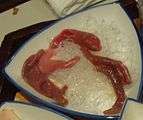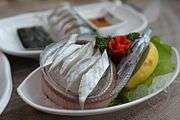Hoe (food)
Hoe (회; 膾/鱠) refers to several varieties of raw food dishes in Korean cuisine. There is record of it being consumed since the Three Kingdoms of Korea (57 BC - 668 AD), and has been a major Korean dish ever since.
.jpg) | |
| Alternative names | Hwe |
|---|---|
| Type | Raw fish |
| Place of origin | Korea |
| Associated national cuisine | Korean cuisine |
| Variations |
|
| Korean name | |
| Hangul | 회 |
|---|---|
| Hanja | 膾; 鱠 |
| Revised Romanization | hoe |
| McCune–Reischauer | hoe |
| IPA | [hwe̞] |
 |
| This article is part of a series on |
| Korean cuisine 한국 요리 조선 료리 |
|---|
|
Staples |
|
Condiments
|
|
Other
|
Varieties
There are uncooked hoe (회) as well as blanched sukhoe (숙회).[1][2]
Raw
Hoe (회), the raw fish or meat dish, can be divided into saengseon-hoe (생선회), filleted raw fish, and yukhoe (육회), sliced raw meat.[3][4] Saengseon-hoe (생선회) can be either hwareo-hoe (활어회) made from freshly killed fish, or seoneo-hoe (선어회) made using aged fish. Mulhoe (물회) is a cold raw fish soup.[5]
- Baemjangeo-hoe (뱀장어회) – freshwater eel
- Baendaengi-hoe (밴댕이회) – sardinella
- Bangeo-hoe (방어회) – amberjack
- Bungeo-hoe (붕어회) – Crucian carp
- Daegu-hoe (대구회) – cod
- Dorumuk-hoe (도루묵회) – sandfish
- Gaebul-hoe (개불회) - fat innkeeper worm
- Gajami-hoe (가자미회) – righteye flounder
- Gamulchi-hoe (가물치회) – snakehead
- Gehoe (게회) – crab
- Gul-hoe (굴회) – oyster
- Gwangeo-hoe (광어회) – olive flounder
- Haesam-hoe (해삼회) – sea cucumber
- Hongeo-hoe (홍어회) – skate
- Ingeo-hoe (잉어회) – carp
- Jari-hoe (자리회) – chromis
- Jogae-hoe (조개회) – clam
- Jogi-hoe (조기회) – yellow croaker
- Junchi-hoe (준치회) – ilisha
- Mineo-hoe (민어회) – brown croaker
- Muneo-hoe (문어회) – giant octopus
- Myeongtae-hoe (명태회) – pollock
- Nakji-hoe (낙지회) – long arm octopus
- Nongeo-hoe (농어회) – seabass
- Saengbok-hoe (생복회) – abalone
- San-nakji (산낙지) – long arm octopus
- Ssogari-hoe (쏘가리회) – mandarin fish
- Sungeo-hoe (숭어회) – mullet
Preparation
Hwareo-hoe (활어회) is prepared by filleting freshly killed fish, while seoneo-hoe (선어회) is made with aged fish in a similar way as Japanese sashimi: removing the blood and innards and ageing the fish at a certain temperature before filleting.[7][8] Fish or seafood hoe is often served with gochujang-based dipping sauces, such as cho-gochujang (chili paste mixed with vinegar) and ssamjang (chili paste mixed with soybean paste). Hoe is often eaten wrapped in ssam (wrap) vegetables, such as lettuce and perilla leaves. After eating hoe at a restaurant, maeun-tang (spicy fish stew) made with the bones, head, and the remaining meat of the fish, can be served as an add-on dish.
History

Historians assume the tradition of eating hoe was imported from China to Korea early in the Three Kingdoms period (57 BC-668 AD), facilitated by frequent exchanges between China and Korea on the Korean peninsula.
With the popularization of Buddhism in Korea, beginning in the middle of the Three Kingdoms period, and running late into the Goryeo Dynasty (918–1392), the consumption of fish and other meat products (including hoe) declined. As the influence of Buddhism waned in the late Goryeo Dynasty period, the consumption of hoe began to lose its stigma.
During the Joseon Dynasty, the state promoted Confucianism, and, as Confucius was known to have enjoyed eating raw meat, hoe consumption greatly increased.[9]
Gallery
 Various hoe
Various hoe Bangeo-hoe (raw amberjack)
Bangeo-hoe (raw amberjack) Gaebul-hoe (raw fat innkeeper worm)
Gaebul-hoe (raw fat innkeeper worm) Godeungeo-hoe (raw chub mackerel)
Godeungeo-hoe (raw chub mackerel) Galchi-hoe (raw largehead hairtail)
Galchi-hoe (raw largehead hairtail) Gulhoe (raw oysters)
Gulhoe (raw oysters) Horaegi-hoe (raw loliolus squid)
Horaegi-hoe (raw loliolus squid) Jaridom-hoe (raw pearl-spot chromis)
Jaridom-hoe (raw pearl-spot chromis) Muneo-hoe (raw giant octopus)
Muneo-hoe (raw giant octopus) Ojingeo-hoe (raw flying squid)
Ojingeo-hoe (raw flying squid) Jeonbok-mulhoe (cold raw abalone soup)
Jeonbok-mulhoe (cold raw abalone soup) Hoe-muchim (seasoned hoe salad)
Hoe-muchim (seasoned hoe salad) Hoe-naengmyeon (cold noodles with hoe)
Hoe-naengmyeon (cold noodles with hoe).jpg) Hoe-deopbap (bibimbap with hoe)
Hoe-deopbap (bibimbap with hoe)
See also
References
- "hoe" 회. Standard Korean Language Dictionary (in Korean). National Institute of Korean Language. Retrieved 3 June 2017.
- "sukhoe" 숙회. Standard Korean Language Dictionary (in Korean). National Institute of Korean Language. Retrieved 3 June 2017.
- "saengseon-hoe" 생선회. Standard Korean Language Dictionary (in Korean). National Institute of Korean Language. Retrieved 3 June 2017.
- "yukhoe" 육회. Standard Korean Language Dictionary (in Korean). National Institute of Korean Language. Retrieved 3 June 2017.
- "mulhoe" 물회. Standard Korean Language Dictionary (in Korean). National Institute of Korean Language. Retrieved 3 June 2017.
- "ganghoe" 강회. Standard Korean Language Dictionary (in Korean). National Institute of Korean Language. Retrieved 3 June 2017.
- 김, 경운 (26 October 2015). "[김경운 기자의 맛있는 스토리텔링 15] 선어회와 활어회". Seoul Shinmun (in Korean). Retrieved 3 June 2017.
- 여성조선 (27 March 2017). "고기와 생선, 숙성의 맛". The Chosun Ilbo (in Korean). Retrieved 3 June 2017.
- Kim Hak-min (김학민) (2003-07-16). 공자 사모님 힘드셨겠네 (in Korean). The Hankyoreh. Retrieved 2008-08-23.
